One Year After Introducing a New Corporate Identity,
What NOK's Visible Impact Reveals About the Power of Creativity in B2B
Improving the Sense of Belonging: A Brand Identity Milestone
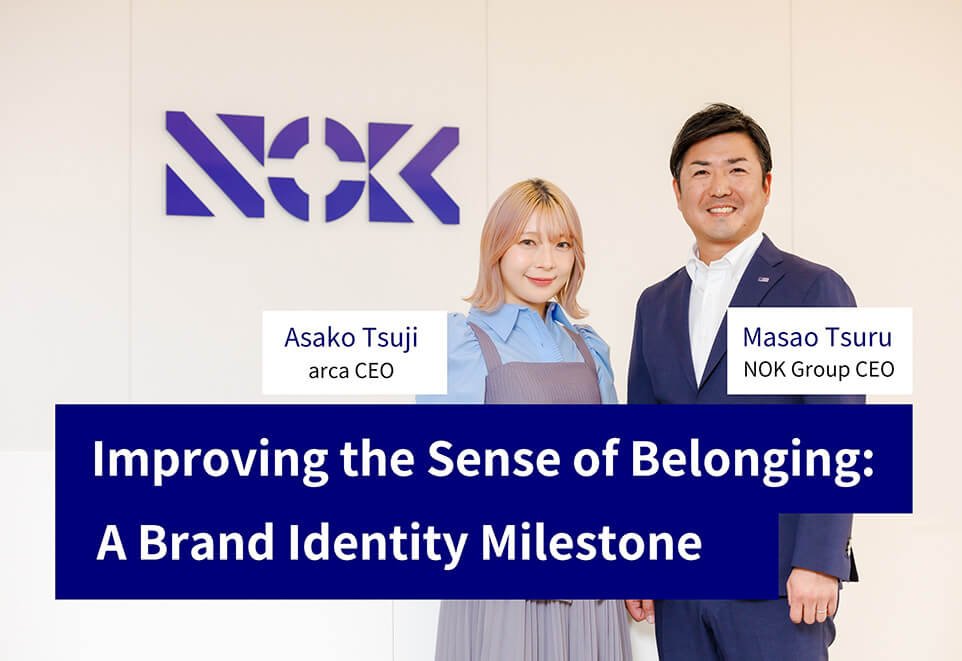
The NOK Group was founded in 1941 and has established a unique position as a Japanese manufacturer known among insiders in the auto parts and precision device industries.
The company enjoys a 70% share of the domestic market for oil seals, which are used in car engines and other applications, and is third in the world in sales of flexible printed circuits (FPC), which are used in precision information devices.
In April 2024, NOK, a company that had long operated behind the scenes, commissioned creative director Kashiwa Sato to lead a bold refresh of its corporate identity (CI), marking a deliberate step into greater visibility.
One year has now passed since the NOK Group made the decision to change direction as a company. So, how has it changed? To find out, we hosted a conversation between Asako Tsuji, who focuses on socially aware creativity and has contributed to numerous brand policies centered on DE&I, and NOK Representative Director and Group CEO Masao Tsuru.
Stepping into the Spotlight: Redefining NOK's Identity
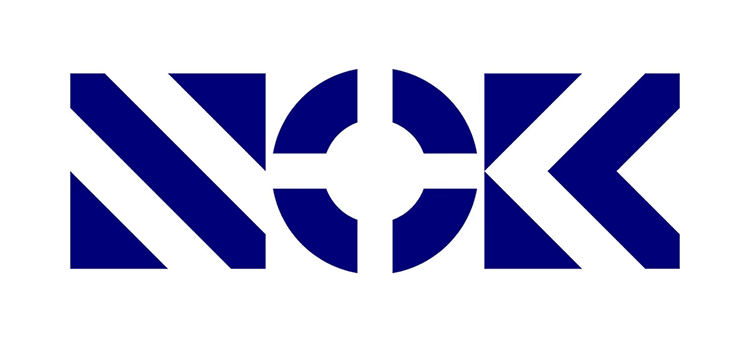
- Ms. Tsuji, what was your first impression of the NOK Group's new CI?

Asako Tsuji: arca CEO and creative director. Focusing on socially aware creativity, she is a creator who goes beyond boundaries, working across everything from advertising to product production regardless of the field. Her work pivots on two principles: creating businesses rooted in concept and social awareness and creating products with a distinct worldview. From real events to product planning and brand production, she is engaged in creative work across a wide range of genres. In the spring of 2019, she launched the Ladyknows project on the theme of women's empowerment and healthcare.
Tsuji: I first saw NOK's new logotype on an advertisement on a moving taxi. The bold yet delicate logo caught my eye and stuck with me. Later, when I read an article explaining the background to the new CI, I was struck by how the brand has been redefined: not as something quietly supporting from behind the scenes, but as something expanding outward from the center. Although the company's business domain has long had the image of an unsung hero - quietly providing support - the new identity boldly positions is as playing a central role. That, in creative terms, is how storytelling works. I believe the message carries great significance for the people who work at NOK, and I feel it beautifully captures the pride and spirit of Japanese manufacturing.
- What led to the decision to redefine NOK's corporate identity?
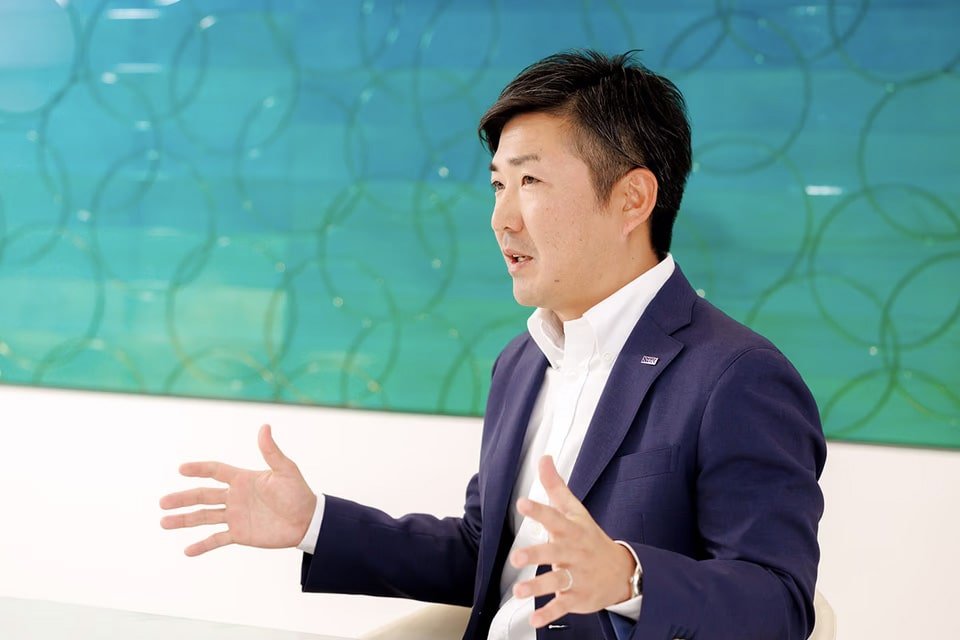
After joining NOK, Tsuru obtained an MBA and was involved in finance control with partner company Freudenberg & Co. of Germany. Upon returning to Japan, he worked to strengthen NOK's business alliance with Freudenberg & Co. as a member of NOK's Corporate Planning Office. In 2018 he was appointed president and representative director of a Group company, NOK KLUEBER CO., LTD., and conducted active technology exchange. After returning to NOK, he served in management in the Corporate Business Strategy Office before being appointed to his current position in April 2021.
Tsuru: Japanese companies labeled as JTC*1 often carry the negative image of having stagnated. But I'm skeptical of that view. If perceived quality*2 were raised alongside product quality, these companies could fully realize their potential, and I believe there's still ample room for global growth. When I was appointed president in 2021, the global market in the mainstay automobile industry was already undergoing major change with the shift to electric vehicles and the rise of Chinese manufacturers. In this context, the traditional low-profile stance of parts manufacturers - once seen as a quiet strength - had, in this changing environment, turned into a disadvantage.
While I have full confidence in our manufacturing technologies and sales capabilities, we lacked the ability to communicate our strengths. There was a real sense of urgency: unless we found a way to raise the NOK Group's visibility, both internally and externally, and enhance our corporate value, we risked falling into decline.
- A colloquial abbreviation for "Japanese traditional company." Often used somewhat critically to describe companies with outdated value systems or legacy corporate cultures.
- Perceived quality: The quality and sense of superiority that consumers attribute to a product when comparing it with alternatives.
- How did the collaboration with Kashiwa Sato begin?
Tsuru: Initially, I didn't approach him about our CI or logo. I spoke with him about a more fundamental concern: how to communicate our presence - internally and externally - and how to raise our value as a company.
Kashiwa didn't respond by immediately offering a solution; instead, he took the time to speak with executives, visited worksites and carefully absorb what we shared.
Out of this process, two major issues became clear. The first was that, since our founding, each Group company had developed its own CI and conducted communications independently, which was inefficient. The second was how to express the idea that, while NOK stands as the leader and the 92 Group companies are united under it, each company should be treated as an equal member. The new CI was born from that thinking.
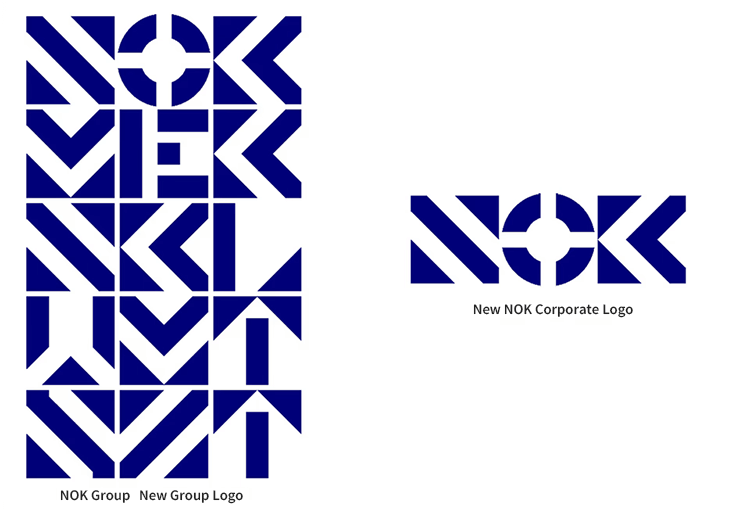
Our Actions and the Meaning of the new CI Have Come to Overlap
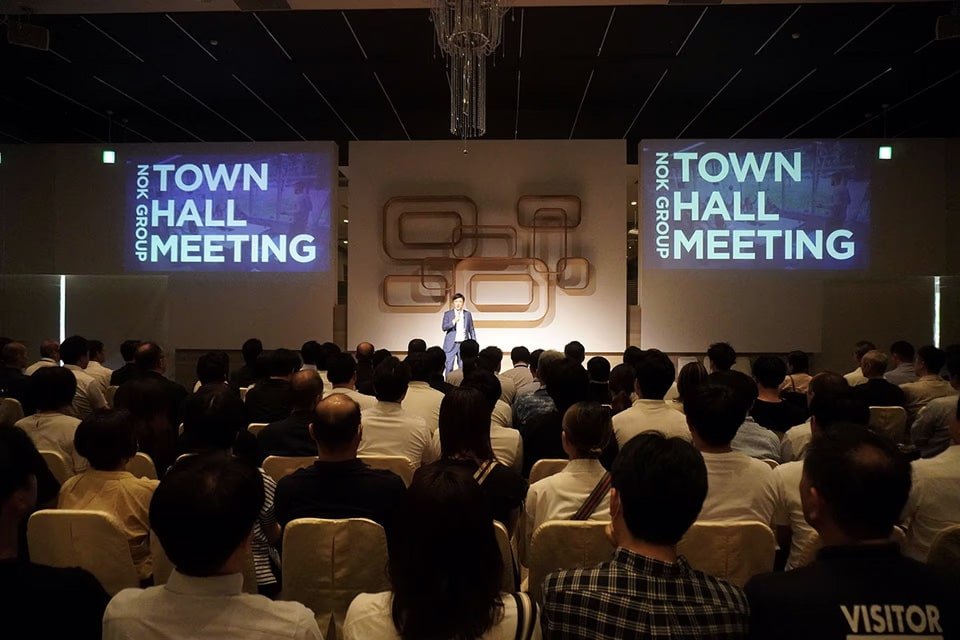
- One year has passed since the new CI was introduced. What specifically has changed?
Tsuru: Through town hall meetings, I've personally explained the intention behind the new CI to employees and created space for open dialogue. Lately, I've heard people say that the old logo now feels outdated. I don't think this is simply a matter of becoming visually accustomed to the new logo; it's proof that our actions have come to overlap with the meaning of the CI.
Tsuji: I've also been involved in several CI and brand identity refreshment projects. What I always realize in those moments is that, no matter how deeply an external partner thinks things through, their understanding of a company's history can never match that of the people who have actually worked there.
At the same time, it is precisely because we come from the outside that we can help uncover a company's deeper appeal and values, and give shape to its identity. The key is aligning our perspective with that of the client. A company's strengths often feel too obvious to those inside, so much so that their value can go unnoticed. This is true for companies and individuals: it often takes an outside perspective to help reveal what makes something unique and compelling.
When a CI or VI developed through this kind of process gradually starts to penetrate the client's organization, when conversations emerge and everyone begins to take ownership of it, the process is truly rewarding to the creator. It's like watching your creation leave your hands, take a breath and come to life.
I think it's precisely because someone like Mr. Tsuru communicates from the center outward, rather than from the top down, that this CI could take the shape it did.
Tsuru: Thank you for those positive comments. I hold town hall meetings at our overseas sites as well, and I believe employees understand that the CI change isn't just about appearance. Recently, I've seen overseas teams start to explore new businesses inspired by NOK values, and there's been more movement in terms of personnel exchanges and transfers. I truly feel that we're evolving into a global company.
The "Be" and "Do" of a Corporate Identity
- So, the new CI is having a positive impact on global business as well.
Tsuru: Since July 2024, the NOK Group has adopted a system called a global matrix. Each business operates along a vertical axis, while corporate functions are developed along a horizontal axis, a structure we refer to as "multiplication management."
What's more, the fact that Kashiwa Sato was involved in creating the new CI carries significant meaning. Kashiwa has worked with many well-known companies, and he was able to give language and form to the qualities that make NOK special. For us, both myself and our employees, those qualities had become so familiar they felt obvious. Through this process, we were able to recognize their true value, and that realization has given us a renewed sense of confidence.
- It also became an opportunity to define a clearer identity for the company.

Tsuji: When thinking about identity, Japanese culture tends to arrive at "Be" only after a long history of "Do." In other words, we've done all these things - and that's why we are who we are. Identity is seen as the accumulation of action over time. In contrast, global corporations often take the opposite approach: "Be" often comes first. They start by defining a clear mission, vision, and purpose and then backcast the "Do" from there.
Neither approach is inherently better; it's simply a cultural difference. That said, when design or vision alone takes the lead, the process can sometimes stop at surface-level glamor or empty words. Without a substance behind the change, there's little chance for truly meaningful progress.
From that perspective, NOK has a deep and tangible history. Its people have developed technologies and expertise over time, with their own two hands. It is precisely because of the accumulated "Do" that we're now able to consider how to give form to "Be," through language and design. Very few companies manage to achieve such a good balance.
Tsuru: The NOK Group aims not only to improve product quality but to raise the overall quality of the company, including our people. We want to be recognized as a company with great products, a great culture, and great people.
What is the Unchanging Essence in Changing Times?
Tsuji: I am often asked for branding advice in the context of DE&I, diversity, equity and inclusion. But what really matters is having an essence that remains constant, even in changing times. After all, the diversity of society and the uniqueness of each company have always existed. These aren't passing trends.
The way we deliver that essence may shift with the times. But the core itself doesn't change. In fact, when everything around us starts to shift, and we feel pulled in different directions, what we return to is our identity, the shared language and design that reflect who we are.
Recently, the idea of belonging has gained more attention in the DE&I space. Diversity is important, but simply chasing diversity for its own sake can backfire. Ironically, it can lead to companies becoming more alike, with everyone aiming for the same numbers and the same ratios, and losing what makes them unique.
That's why having a clear, authentic identity is so important. It helps create a sense of belonging that's grounded in who you are, not just in numbers. And it's not enough to declare that identity; it has to be embedded in day-to-day operations, in management systems, organizational management policies, and leadership behavior. NOK's efforts are a great example of this.
Tsuru: Our reforms have only just begun. Compared to the company's long history, this is still a short phase. I don't think we've reached the point where we can say that a real sense of belonging has taken hold. But when our values become second nature to the people who work here, that's when they'll become part of the company culture. We also need to keep reaching out to new employees as they enter.
When I give town hall meetings, people resonate with the ideas and get excited about putting them into practice. But once they return to their own departments, the reality is that it's hard to maintain that energy, and they often slip back into old habits and familiar routines.
This is why we are implementing various measures to rekindle that enthusiasm. These include holding mini town hall meetings at worksites and sending out regular video messages to reinforce our direction. People are people, so awareness naturally fades over time. That's why continuing to build and maintain that awareness is one of the most important aspects of human capital management.
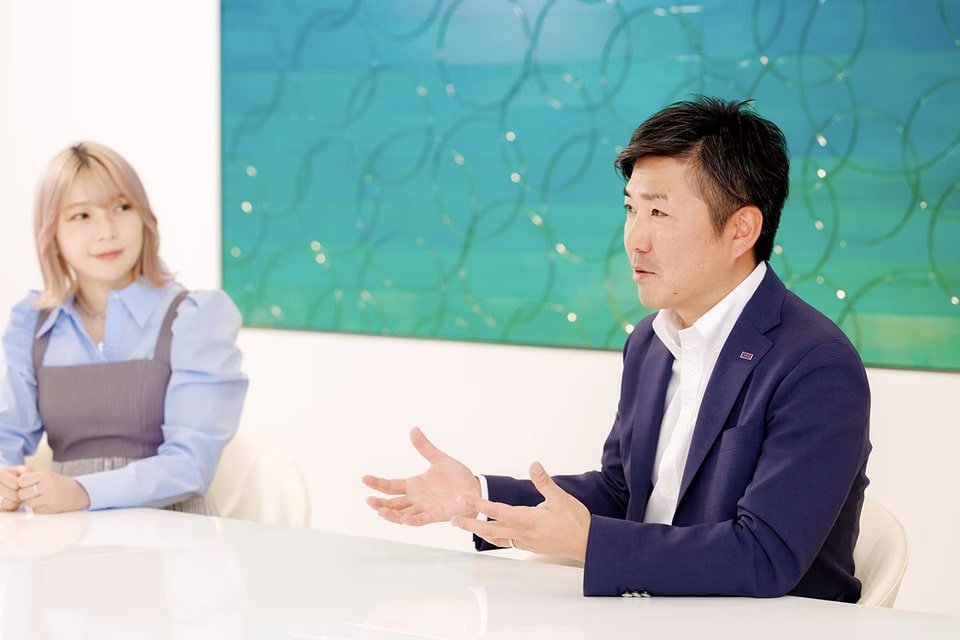
Tsuji: Given NOK's scale, I don't think it's surprising that a strong organizational subjectivity, something larger than the individual, would naturally emerge. But even so, I get the sense that Mr. Tsuru consistently keeps employees and human capital management at the center of everything he does.
Recently, I was inspired by the critic Tsunehiro Uno's book Think as a Garden. In today's world, we are rapidly losing the physical experience of touching the soil and tending to plants. Working with our hands in digital, texture-less spaces, it is inevitably harder to feel that direct connection to what we create. As a result, it becomes difficult to find a clear sense of identity or fulfillment in the work we commit ourselves to. This is why Think as a Garden encourages a return to the physical.
And in that sense, NOK's approach to manufacturing is especially meaningful. It reflects a continued commitment to making tangible things and honoring the people who make them.
Tsuru: We are proud of our manufacturing; it's a core part of NOK's corporate culture, passed down from generation to generation. Ultimately, business is driven by what happens on the worksites and frontlines. The people of the NOK Group are truly people to be proud of. The essence of our company exists at the worksite.
Tsuji: Hearing a manager say that is truly inspiring. I imagine that must mean a lot to everyone at NOK.
Tsuru: Next time, I'd love for you to visit one of our worksites. Talking like this only goes so far, you have to see it for yourself to really understand the essence of the NOK Group.
Discover Our Brand StoryArticle current as of March 19, 2025